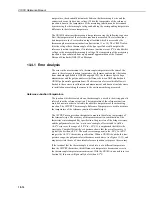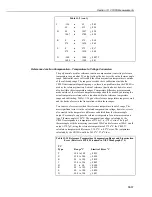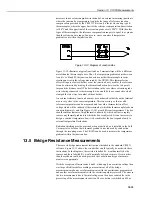
Section 13. CR10X Measurements
13-5
V
s
= V
so
(1-e-t/R
o
C
T
), rise
[1]
V
s
= V
so
+ (V
eo
-V
so
) e-t/R
o
C
T
, decay
[2]
where V
s
is the input voltage, V
so
the true signal voltage, V
eo
the peak transient
voltage, t is time in seconds, R
o
the source resistance in ohms, and C
T
is the total
capacitance between the signal lead and ground (or some other fixed reference
value) in farads.
The settling time constant,
τ
in seconds, and the capacitance relationships are
given in Equations 3 to 5.
τ
= R
o
C
T
[3]
C
T
= C
f
+ C
w
L
[4]
C
f
= 3.3nF
[5]
where C
f
is the fixed CR10X input capacitance in farads, C
w
is the wire capaci-
tance in farads/metre, and L is the wire length in metres.
Equations 1 and 2 can be used to estimate the input settling error, V
e
, directly. For
the rising case, V
s
= V
so
-V
e
, whereas for the decaying transient,
V
s
= V
so
+V
e
. Substituting these relationships for V
s
in Equations 1 and 2,
respectively, yields expressions in V
e
, the input settling error:
V
e
= V
so
e-t/R
o
C
T
, rise
[6]
V
e
= V
e
'
o
e-t/R
o
C
T
, decay
[7]
Where V
e
'
o
= V
eo
-V
so
, the difference between the peak transient voltage and the
true signal voltage.
Since the peak transient, V
eo
, causes significant error only if it is
several times larger than the signal, V
so
, error calculations made in
this section approximate V
e'o
by V
eo
; i.e. V
eo
= V
eo
-V
so
.
If the input settling time constant,
τ
, is known, a quick estimation of the settling
error as a percentage of the maximum error (V
so
for rising, V
e'o
for decaying)
is obtained by knowing how many time constants (t/
τ
) are contained in the 450µs
CR10X input settling interval (t). The familiar exponential decay relationship is
given in Table 13-1 for reference.
Table 13-1 Exponential Decay, Percent of Maximum Error vs. Time in Units
of
ττττ
Time
%
Time
%
Constants
Max. Error
Constants
Max. Error
0
100.0
5
0.7
1
36.8
7
0.1
3
5.0
10
0.004
Before proceeding with examples of the effect of long lead lengths on the meas-
urement, a discussion on obtaining the source resistance, R
o
, and lead capacitance,
C
w
L, is necessary.
NOTE
















































